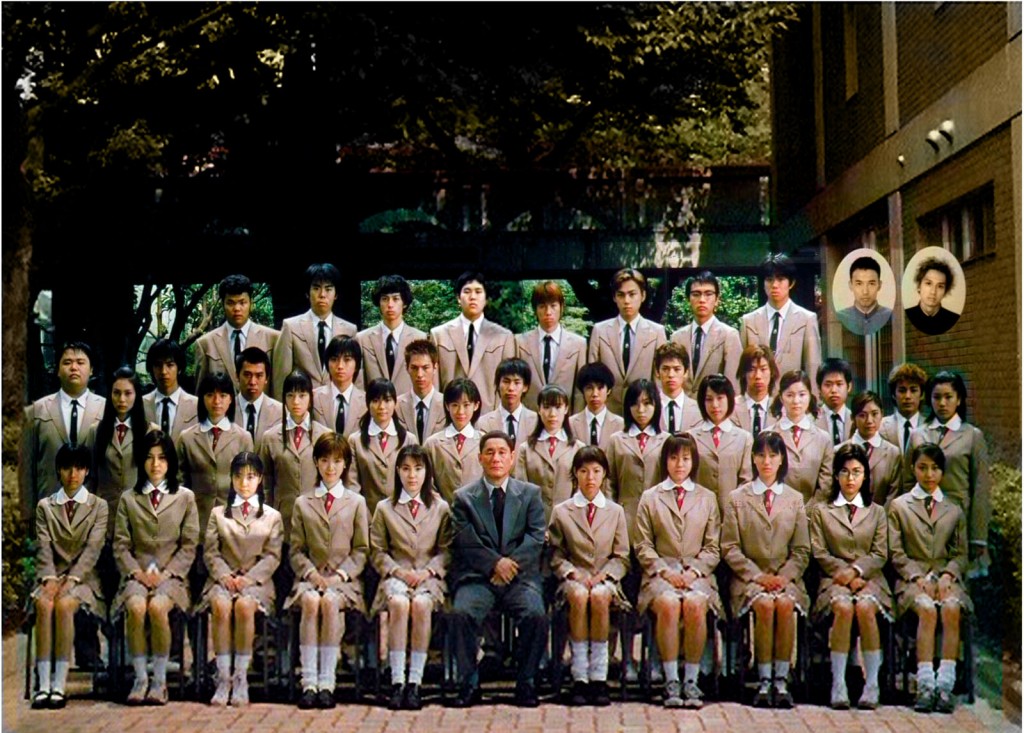Battle Royale Review
 Originally released in 2000 Battle Royale was a mini phenomenon in its native Japan and also overseas, aided somewhat by the controversy that surrounded it. When the Japanese censorship board, Eirin, checked a rough cut of the film they pointed out particular scenes that they felt should be cut, advice that director Kinji Fukasaku ignored. The film was therefore slapped with the R-15 certification, a rarity for a mainstream Japanese film and a certificate that prevented anyone under the age of 15 from seeing it.
Originally released in 2000 Battle Royale was a mini phenomenon in its native Japan and also overseas, aided somewhat by the controversy that surrounded it. When the Japanese censorship board, Eirin, checked a rough cut of the film they pointed out particular scenes that they felt should be cut, advice that director Kinji Fukasaku ignored. The film was therefore slapped with the R-15 certification, a rarity for a mainstream Japanese film and a certificate that prevented anyone under the age of 15 from seeing it.
The content of the film and its release coming just a year after the events in Columbine in 1999 insured that American distributors steered clear and it received no official release there. UK distributor Tartan picked up the film though and their now out of print DVD (they folded in 2008) did great business in exports to the US. Following the folding of Tartan films, Arrow Video picked up the rights and their new release boasts not only a new Blu-ray version but also a host of new features.
The Japan of Battle Royale features a new political act, entitled the BR Act, which seeks to address the problems of serious teenage rebellion with a ‘game’ that involves taking a class of school children to a remote island and forcing them to kill each other until only one is left standing. The film focuses on Kitano’s (Takeshi Kitano) class who, believing they are on a class trip, are drugged and taken to the island. Following an induction led by Kitano and featuring an amusing instructional video the class set off individually, each with a pack containing basic supplies and a random weapon. Quickly the children cling to their friendship groups and any relationships, petty rivalries and character traits are magnified by the exceptional circumstances.
Unlike dystopian or post-apocalyptic films featuring a world of the future, Battle Royale positions itself at the turn of the millennium, the time of the films release. Following the opening line ” At the dawn of the millennium, the nation collapsed.” there follows real-life statistics about the problems that Japan faces with teenagers. These are statistics on such problems as truancy and violence and they position the film clearly as present day and specifically within the context of present day Japan, tackling issues that are really taking occurring. The film represents a microcosm of present-day Japan and the fictional island in the film is Japan in miniature, not symbolic of the future of Japan but the present-day. Battle Royale also has as much to do with Japan’s past as it does with the present day. Fukasaku’s films have always been very much post-war films that investigate the social problems of a defeated nation and this is clearly still present in Battle Royale.
The deeply profound experiences that Fukasaku suffered during the war deeply informed the film (the students in the film are the same age as he was in 1945) and although he is now one himself, it seems he still does not trust adults. In interviews at the time of the film’s release he often made a very direct relationship between the situation in Japan in 2000 and post-war Japan. His experiences of post-war Japan and in particular the fall out from untrustworthy politicians and police deeply affected much of his work. When asked in an interview for Midnight Eye if with Battle Royale he was still asking basically the same question? “Where are these politics taking us?” He replied quite simply “Yes”.
One issue with Fukasaku’s approach though is that the politicians implementing the BR Act in Battle Royale are completely unseen, although they are somewhat represented by the most prominent adult figure, Kitano. Fukasaku’s film is ultimately a polemic with (for better or worse – I would argue the former) sledgehammer subtlety. This is also evidenced in the relationships between the schoolchildren and their character beats which are for the most part a little simplistic. The sequence in the lighthouse where the male lead, Nanahara (Tasuya Fujiwara), recuperates whilst a clique of the girls attempt a domestic idyll only for it to collapse is one deft example of Fukasaku’s simplification/economy in character and plot.
Dealing with a large number of characters and constrained by the conceit that they must be dispatched quickly this somewhat simplistic approach is not surprising and the film flows smoothly as a result. This mixture of a large number of characters and plot points each dealt with swiftly and with economy ensure the film is thoroughly enjoyable despite its darker political themes and violent content. This is perhaps largely due to Fukasaku’s attempt to make this film for ‘the kids’, the main reason why the R-15 hurt him so much, and he therefore paints with broad strokes.
Battle Royale is a tad flawed in places, some of the aforementioned economy leaves some aspects a little weak in substance, and it doesn’t seem quite as fresh and exciting ten years on but its political and social themes are still interesting and relevant. Although perhaps lacking in complexity at times the film is also still incredibly entertaining and the action set pieces are well realised through Fukasaku’s expert direction and the fast paced and often thrilling narrative easily hooks you in.
A slightly different version of this review was originally posted at HeyUGuys.